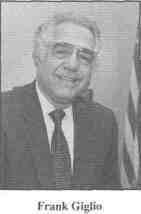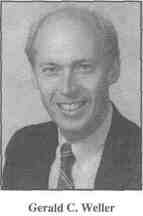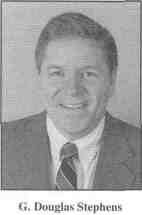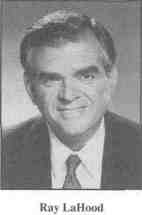By JACK VAN DER SLIK Congressional races to watch
Replacements for Michel, Sangmeister could give GOP
a shot at gaining a seat from Illinois this November
At least two new recruits will join Illinois' congressional ranks next year, giving Republicans a chance to narrow the partisan gap. Democrats hold 12 of the state's U.S. House seats, Republicans eight. But two veterans are leaving the field, creating close contests. Robert H. Michel, the long-time Republican leader from Peoria, is retiring from his 18th district seat. And Mokena Democrat George E. Sangmeister is relinquishing his seat from the south suburban 11th district. Both races are toss-ups. But the GOP, which has been chipping at the Democrats' margin under the current congressional map, has a clear shot at gaining a seat. There are some long-shots as well. Chicago Democratic incumbents Dan Rostenkowski and Mel Reynolds could face last-minute electoral trouble. Both serve on the influential House Ways and Means Committee. Rostenkowski, the former committee chairman who represents the city's northwest side 5th district, stands accused of trading stamps for cash at the House Post Office and hiring "ghost payrollers." Yet, despite a two-year investigation into his political finances, Rostenkowski was renominated handily. He beat his nearest challenger, state Sen. John J. Cullerton of Chicago by a 5-to-3 margin. This fall, he faces a little-known Republican, Michael P. Flanagan. An attorney, Flanagan is making his first run for office. Reynolds, a freshman representing the 2nd district on the city's South Side, has been indicted on charges of sexual assault and child pornography. He also faces a Federal Election Commission probe of his campaign finances. Republicans, who failed to field a challenger in the 2nd district primary, have launched a write-in campaign and designated Carl Bibbs as their candidate. Nevertheless, both Rostenkowski and Reynolds are expected to win re-election November 8. Congressional Quarterly also cites Chicago's 3rd district as a potential victory for the GOP. According to CQ,, voters "seem ambivalent" about re-electing William 0. Lipinski. Meanwhile, his Republican challenger, novice campaigner Jim Nalepa, bills himself as a "conservative alternative to a has-been product of the Democratic machine." The political demographics of that district, however, continue to favor Lipinski. Republicans have some reason for optimism. They've gained one seat and the Democrats have absorbed the loss of three under the state's congressional district map, drawn after the 1990 census. Further, mid-term elections usually favor the non-presidential party and, with Democratic President Bill Clinton's popularity hovering at 50 percent, Republicans are expecting to pick up seats in Illinois and elsewhere. Still, Illinois Democrats appear not to have as much to fear from a partisan backlash as their colleagues in other states. Clinton ran better here than in the rest of the nation: 49 percent of the Illinois vote, compared to 43 percent of the national vote. He continues to maintain good relations with this state's Democrats, tapping several for his administration. Chicago Mayor Richard M. Daley's brother William helped muscle the North American Free Trade Agreement through Congress. And this summer the city was chosen as the site of the party's 1996 national convention. Illinois also lacks some circumstances that bedevil Democrats in other states, including a large organized Christian right. A number of the issues that concern Democrats in other states don't seem as crucial here. Despite Chicago's large ethnic voting bloc, for instance, Clinton's policy on Haitian and Cuban refugees hasn't attracted widespread attention. And so far, the hearings into the Clintons' financial dealings have made little noise. October 1994/Illinois Issues/27 Lineup of candidates for Illinois' 20 House districts
Following are the candidates for the U.S. Congress from Illinois this fall. Names in bold face are the incumbents.
The impact of national issues such as crime, health care and the economy, as well as the day-to-day perception of Clinton's leadership, are most likely to be reflected in the race to fill Sangmeister's seat. The 11th district can swing to either party. The district sprawls across a large and socially diverse area. It takes in some of south Chicago and the suburbs next to the Indiana border, then extends 90 miles west to LaSalle. It encompasses the blue collar city of Joliet and the quiet suburbs of South Holland and Lansing. It takes in Chicago's old 10th ward, where political maverick Ed Vrdolyak turned from regular Democrat to Reagan Republican. And it includes Grundy and LaSalle counties where support for the parties is evenly divided. The district was competitive in 1992 when Sangmeister was seeking re-election and Clinton was winning the presidency. Sangmeister defeated a relatively unknown Republican opponent, Robert T. Herbolsheimer, by only 56 percent to 44 percent. The partisan balance of the district is further indicated by the turnout in this year's primary: Democrats drew 39,000 voters, while Republicans attracted 36, 000. This primary also drew more contenders than any other Illinois congressional district. There were seven Democrats running, including two incumbent state representatives and one state's attorney, Dave Neal of Grundy County. (Neal was subsequently appointed to fill the Democratic vacancy for the 75th district House race.) The Democratic congressional winner, state Rep. Frank Giglio of Calumet City, a 20-year Statehouse veteran, edged state Rep. Clem Balanoff of Chicago by less than two percentage points. The Cook County Democratic organization supported Giglio. In the general election Giglio can count on help from Illinois House Speaker Michael J. Madigan and from the regular Democrats who worked for Sangmeister. 28/October1994/Illinois Issues
Republicans, meanwhile, spread their votes over six candidates. State Rep. Gerald "Jerry" C. Weller of Morris beat the 1992 nominee, Herbolsheimer, and former state Rep. Sam Panayotovich of Chicago. Weller prevailed with less than 32 percent of the Republican vote. Giglio and Weller are experienced careerists making calculated moves to the legislative big league. As such, they are evenly matched in their ability to draw support and dollars. Giglio has been winning election to the legislature since the early 1970s. And, while Weller hasn't spent as many years in elected office, he's shown considerable drive and tenacity. In 1986, after winning the Illinois House district by four votes, Weller was bounced on a recount. He ran again and won. Weller — who says he's wanted to be in Congress since childhood — has been a full-time lawmaker since 1988. The national momentum appears to favor the Republican in this district. However, if neither contender gains a clear lead by mid-October, a national surge or decline in presidential popularity could affect the outcome. The battle in the 18th district, on the other hand, will likely be won or lost on local issues. The district, with Peoria at its heart, has been Bob Michel territory for almost 40 years. Michel has chosen to pass the baton to his long-time Chief of Staff Ray LaHood. That is not surprising. Michel, who once worked on a congressional staff, succeeded his former boss in 1956. Once part of the Republican heartland, the new district went for Clinton in 1992, with 42 percent over Bush's 41 percent and Perot's 17 percent. A union-supported opponent held Michel to 58 percent that same year. This year, the Democrats are fielding a well-known, union-oriented trial lawyer, G. Douglas Stephens. Twice before, in 1982 and 1988, Stephens held Michel to slim victories when Democratic opponents were hard to come by. This year, the open seat attracted several challengers, and Stephens beat two opponents for the nomination, including a well-known state legislator, Rep. Thomas J. Homer of Canton. LaHood also defeated two other contenders, including Judy Koehler, a former state legislator who lost a bid for the U.S. Senate in 1986. The long-running Caterpillar labor dispute, pitting the United Auto Workers against the company, has helped to polarize this race. LaHood and Stephens are viewed as surrogates for management and labor, respectively, during the current strike. Labor support still may not be enough for Stephens, though, if history repeats itself. In 1982, he had tremendous UAW support and could not defeat the powerful Peoria Republican. LaHood, meanwhile, may hope his long association with Michel — as well as growing divisiveness among union members over the strike — will pay off. CONTINUED REGIONAL CONTROL ELSEWHERE Outside those two contested districts, there is little likelihood of partisan shift. Like Gaul, Illinois is divided into three parts. Chicago Democrats are expected to hang onto their seven districts. Suburban Republicans have a good grip on four seats. Henry J. Hyde, who represents the 6th district from Bensenville, is expected to have little trouble beating his Democratic, Libertarian and United Independents challengers. And, though that region has more partisan diversity, all downstate incumbents are expected to win re-election. Jack R. Van Der Slik is the director of the Illinois Legislative Studies Center at Sangamon State University, and editor of The Almanac of Illinois Politics. His forthcoming book is One for All and All for Illinois: Representing the Land of Lincoln in Congress, to be published early in 1995. Next month in Illinois Issues When does health become a political issue and what should we expect to know about candidates' health? Motorola: Is this one of the best corporations in the world? Why? The baseball players' strike was hot news early this fall. Did you know that Major League Baseball's lobbyist in Washington has strong ties to Illinois? October 1994/Illinois Issues/29
|
|||||||||||||||||||||




